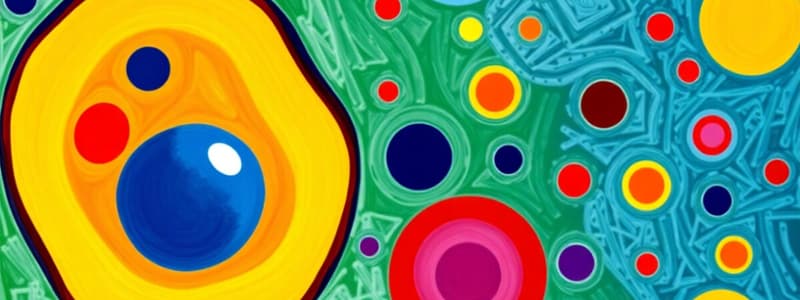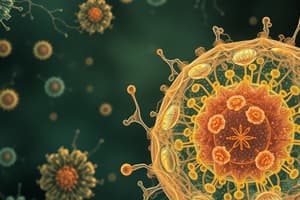Podcast
Questions and Answers
How many chromosomes are present in each human cell?
How many chromosomes are present in each human cell?
- 92 chromosomes
- 46 chromosomes (correct)
- 44 chromosomes
- 23 chromosomes
What is a characteristic of anucleated cells?
What is a characteristic of anucleated cells?
- They contain one nucleus
- They contain multiple nuclei
- They are incapable of dividing (correct)
- They can divide into daughter cells
What type of cell becomes polynucleated during development in humans?
What type of cell becomes polynucleated during development in humans?
- Blood cells
- Nerve cells
- Epithelial cells
- Skeletal muscle cells (correct)
What is the role of the nucleus in a eukaryotic cell?
What is the role of the nucleus in a eukaryotic cell?
What initiates the breakdown of the nucleus?
What initiates the breakdown of the nucleus?
What type of cancer is associated with multinucleated giant cells?
What type of cancer is associated with multinucleated giant cells?
Which is a function of RNA polymerases in the nucleus?
Which is a function of RNA polymerases in the nucleus?
What disorder may be linked to defective nucleoli?
What disorder may be linked to defective nucleoli?
Which organelle is known as the site of ribosome synthesis?
Which organelle is known as the site of ribosome synthesis?
What is the role of the nuclear membrane?
What is the role of the nuclear membrane?
What type of chromatin is considered less compact and routinely expressed within the cell?
What type of chromatin is considered less compact and routinely expressed within the cell?
Which structure within the nucleus is composed of rRNA and proteins?
Which structure within the nucleus is composed of rRNA and proteins?
What forms when chromatin condenses during cell division?
What forms when chromatin condenses during cell division?
Which of the following is NOT a component of the nucleus?
Which of the following is NOT a component of the nucleus?
Which organelle is involved in the synthesis, storage, and export of molecules in a cell?
Which organelle is involved in the synthesis, storage, and export of molecules in a cell?
What is the function of nuclear pores in the nuclear membrane?
What is the function of nuclear pores in the nuclear membrane?
What are anti-nuclear antibodies (ANA) associated with?
What are anti-nuclear antibodies (ANA) associated with?
What is the primary function of the smooth endoplasmic reticulum?
What is the primary function of the smooth endoplasmic reticulum?
Which type of endoplasmic reticulum is embedded with ribosomes?
Which type of endoplasmic reticulum is embedded with ribosomes?
What substance does the cytoplasm primarily consist of?
What substance does the cytoplasm primarily consist of?
How does the rough endoplasmic reticulum assist with protein management?
How does the rough endoplasmic reticulum assist with protein management?
What role does the endoplasmic reticulum play in the cell?
What role does the endoplasmic reticulum play in the cell?
Which of the following is NOT a function of the smooth endoplasmic reticulum?
Which of the following is NOT a function of the smooth endoplasmic reticulum?
What does the smooth endoplasmic reticulum help detoxify?
What does the smooth endoplasmic reticulum help detoxify?
What directs proteins to the endoplasmic reticulum (ER)?
What directs proteins to the endoplasmic reticulum (ER)?
What are the three main structures observed in the Golgi apparatus under electron microscopy?
What are the three main structures observed in the Golgi apparatus under electron microscopy?
Which side of the Golgi apparatus acts as a receiving dock for products?
Which side of the Golgi apparatus acts as a receiving dock for products?
What happens to products as they travel through the Golgi apparatus?
What happens to products as they travel through the Golgi apparatus?
What consequence can result from defects in Golgi function?
What consequence can result from defects in Golgi function?
What is the smallest structural and functional unit of organisms?
What is the smallest structural and functional unit of organisms?
Which of the following characteristics is NOT associated with cells?
Which of the following characteristics is NOT associated with cells?
Which of the following statements about prokaryotic cells is true?
Which of the following statements about prokaryotic cells is true?
What is the primary function of the nucleus in a cell?
What is the primary function of the nucleus in a cell?
What is a key difference between prokaryotic and eukaryotic cells?
What is a key difference between prokaryotic and eukaryotic cells?
What process do all cells undergo to duplicate?
What process do all cells undergo to duplicate?
Which of the following contains the liquid cytosol and organelles?
Which of the following contains the liquid cytosol and organelles?
Which statement correctly describes ribosomes in prokaryotic cells?
Which statement correctly describes ribosomes in prokaryotic cells?
Flashcards are hidden until you start studying
Study Notes
Cell Theory
- Cells serve as the fundamental structural and functional units of living organisms.
- Every organism is made up of one or more cells.
- Cells originate solely from preexisting cells through cell division.
Characteristics of a Cell
- Capable of storing genetic information.
- Engages in energy production and utilization.
- Exhibits movement abilities.
- Senses and responds to environmental stimuli.
- Undergoes duplication for growth, repair, reproduction, and development.
- Maintains homeostasis through self-regulation.
- Synthesizes essential molecules like proteins, carbohydrates, fats, and nucleic acids.
Types of Cells
- Prokaryotic Cells: Lack a true nucleus and membrane-bound organelles. Generally unicellular, with DNA as a single circular strand.
- Eukaryotic Cells: Possess a true nucleus and membrane-bound organelles. Can be unicellular or multicellular, containing multiple linear DNA strands with associated proteins.
Prokaryotes vs. Eukaryotes
- Size: Prokaryotic cells are typically less than 10 µm; eukaryotic cells range from 10 to 100 µm.
- Nucleus: Prokaryotes lack a true nucleus, while eukaryotes have a membrane-bound nucleus.
- Organelles: Prokaryotes have no membrane-bound organelles; eukaryotes do.
- DNA: Prokaryotes' DNA is circular and non-associated with proteins; eukaryotes' DNA is linear and protein-associated.
- Ribosome Size: Prokaryotic ribosomes are small, whereas eukaryotic are larger.
- Reproduction: Prokaryotes reproduce only asexually via binary fission; eukaryotes can reproduce sexually or asexually through mitosis and meiosis.
Three Important Cell Regions
- Cell Membrane: The outer boundary protecting the cell.
- Nucleus: The control center containing DNA, regulating cell function.
- Cytoplasm: The gel-like substance between the nucleus and cell membrane where organelles are suspended.
Organelles of the Cell
- Connected through the endomembrane system.
- Function collectively in synthesis, storage, and export of molecules.
The Nucleus
- Largest organelle in animal cells, composed of:
- Nuclear Membrane: Double-layered, containing nuclear pores for substance exchange.
- Nucleoplasm: The liquid similar to cytosol in the cytoplasm.
- Nucleolus: Site of ribosome synthesis, composed of rRNA and proteins.
- Chromatin and Chromosomes: DNA wrapped around histones; forms chromosomes during cell division.
Chromosome Structure
- Composed of nucleosomes (DNA wrapped around histones) and coiling into chromatin fibers for structure during cell division.
- Each human cell typically contains 46 chromosomes.
Cell Types
- Anucleated Cells: Lack a nucleus, unable to divide.
- Polynucleated Cells: Contain multiple nuclei; common in skeletal muscle cells and sometimes in pathological conditions.
Function of the Nucleus
- Stores DNA, directs cell activities including replication, repair, and transcription.
- Contains specific enzymes for transcription and regulation.
- Small molecules enter freely; macromolecules require regulated transport through nuclear pores.
Cytoplasm
- Jelly-like medium where biochemical reactions occur.
- Contains enzymes, substrates, waste products, and organelles.
Endoplasmic Reticulum (ER)
- Network of membranes spread throughout the cytoplasm.
- Smooth ER: Involved in lipid synthesis, detoxification, and calcium ion storage.
- Rough ER: Studded with ribosomes, involved in protein synthesis, storage, and transport to the Golgi apparatus.
Golgi Apparatus
- Functions as a molecular warehouse and processing center.
- Consists of flattened membrane vesicles (saccules) with a cis (receiving) and trans (shipping) face.
- Modifies products received from the ER for transport.
Golgi Functions
- Ships proteins, storage vacuoles, and lysosomes.
- Errors in Golgi function lead to various disorders, including congenital glycosylation disorders, muscular dystrophy, diabetes, cancer, and cystic fibrosis.
Studying That Suits You
Use AI to generate personalized quizzes and flashcards to suit your learning preferences.




